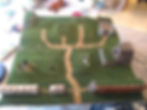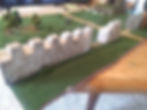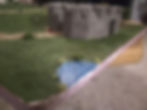An Argument for Gridless Maps
- Aaron K
- Apr 29, 2022
- 4 min read
Hey Reader!

Wow, it's been a while - things have been busy over here, as I had a Middle Earth Strategy Battle Game tournament, am preparing for another one, and my daughter now has TWO TEETH (and working on a few more), so sleep is not happening, :P
But as I was working on a battle board for the tournament, it got me thinking about ways to play roleplay games on non-gridded maps, and what the advantages are to that.
I still play most of my games on gridded maps, but today's post will be an argument for why you should consider playing on a gridless map, and how it changes the focus and gaming experience of your players.
I. Thematic Reasons to Use a Gridless Map

Thematically there are several reasons why you might consider a gridless map instead of a gridded map. The first is the game feels less gamified and more real. There is nothing that says, "This is a game" like grids that tell you how far you can move (well, there are, but you get what we mean).
By seeing grass, hills, etc. instead of lines for a grid, your players feel more transported to a fantasy world optically when they look at the board.
Second, it solves common map issues involving terrain. If you draw or put down a rock on a gridded map, does the rock take up the full square or hex? If you draw a bog on the map and it partially overlaps a tile, is that tile difficult terrain? And of course we cannot forget the math nerd: can I move diagonally, as the hypotenuse is longer than 5 feet? Gridless maps remove all of these issues, as you'll see below.
It also reduces items you need to buy, as you don't need to find a gridded map that has the right dimensions that you need. While you may spend a good bit of money on terrain, the truth is you were probably spending money on terrain anyway, you were just applying them to another part of the map: the gridded paper/poster/whatever.
So with this in the back of our mind, let's look at how to solve mechanical questions, as some game systems have grid-based notes involving combat.
II. Mechanical Considerations
There are four mechanical questions that involve a gridless map: range, movement, auric benefits, and cover. If you play a game that measures range (be it in feet, tiles, etc.), there's an easy to way to incorporate range on a gridless map: make 1" equal to 5 feet or a similar basic measurement. This means that as long as a target is within 1" of your character, they can perform an attack that would target a creature in the next "tile" if you were on a gridded map. And this also works for ranged attacks: if you have a ranged attack of 60ft (or 12 tiles), you can perform that attack action against a target up to 12" away.
This also works for movement: a creature with 30ft of movement could move 6" in a given turn with this system. And if you have to go through difficult terrain or some other impediment, just invoke the penalty to the movement distance: half movement reduces you to 3" and quartered movement would reduce it to 1.5" for example.
Auric benefits can also work in this way, as can area of effect magic spells or abilities. If you give a bonus to persons within 10ft of you, part of the model must be within 2" of you to be affected by the effect. If you have a spell that is medium range wide (6 tiles), or has a 20ft radius (4 tiles), or whatever, it has a radius in inches equal to the number of tiles that would be affected.
Similarly you can do cover far more easily as well as difficult terrain: if you touch or enter the difficult terrain it affects you: if not, you are not affected (so it solves the issue of drawing things on a gridded map that are not squared off or hexagonal). It also allows for the use of actual line of sight to determine cover, as opposed to the typical "top down approach" for gridded maps, as grids are two-dimensional.
So instead of using a grid, you can instead build a scene with terrain that is more thematic and inspiring without having to worry about drawing it on a grid system. But even more than that, there are unique advantages to not using a grid system that are not merely thematic or adaptations to meet the same needs.
III. Unique Advantages

Perhaps the biggest advantage to just using terrain instead of applying terrain to a gridded map is it encourages the party to think three-dimensionally. Making a grid encounter scenario look three-dimensional with variations in height is very hard, as you are working with a two-dimensional medium.
But the moment you remove the grid, you get your party out of thinking two-dimensionally and all that remains is a three-dimensional space for them to see.
Similarly it gives an aesthetic value to your game. We take the time to find beautiful minis for our games (and sometimes we even paint them!), and sometimes we will even make hills, trees, lava pits, houses, and any number of things using liquid resin (lakes, bogs, swamps, etc.) to make our battle maps look even better. And yet, we then put these...on a map that is far less aesthetically pleasing because "we need a grid." If we're putting so much effort into crafting a beautiful environment for our players to explore, why would we not include a beautiful battle map as well?
Conclusion
Battle maps that are evocative and immersive are not that expensive to make (as you can get everything for cheap from your local hardware store), and they add a lot to your game. And anything that you might "require" a board can be solved with a ruler easily enough. So if you have time and want to create a scorched plain, a dark cavern, or a forest clearing, consider using an actual battle board instead of a gridded map.
Until next time,
Aaron